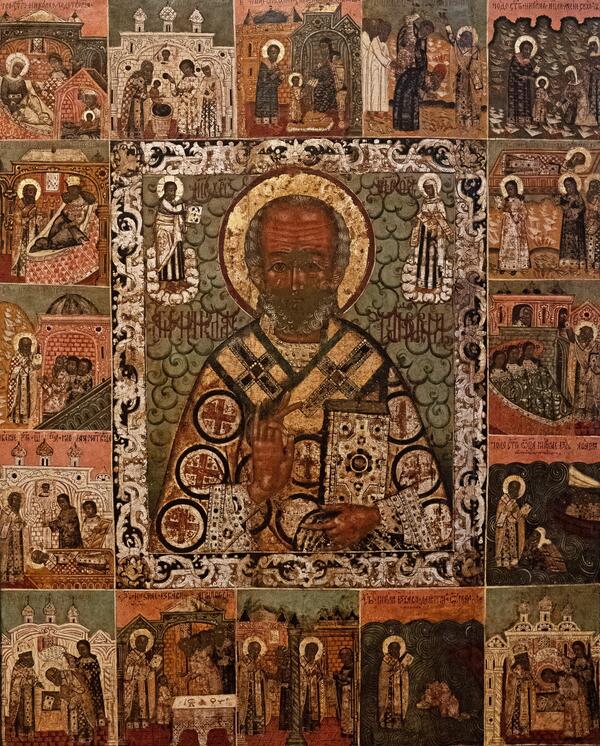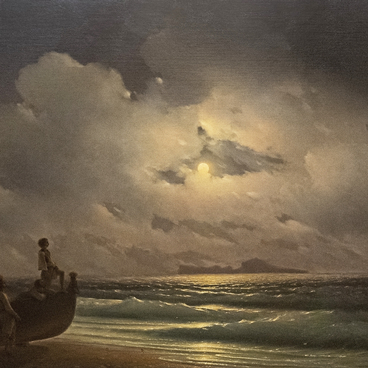The collection of the Rostov Museum of Fine Arts contains the Hagiographical Icon of St. Nicholas. The icon is dedicated to Saint Nicholas the Wonderworker, Archbishop of the city of Myra in the Roman province of Lycia. Born in 270 AD, he was very religious since his early childhood, and studied the Holy Scriptures on his own to devote his life to serving God.
In Christianity, the saint is revered as a miracle worker. In the East, St. Nicholas is considered the patron saint of travelers, prisoners and orphans, and in the West, he is thought to be the main protector of children.
The icon of St. Nicholas belongs to the hagiographic type. The saint is depicted in the center of the icon, and the episodes from his life are rendered in the individual border scenes that surround the central image.
According to the iconographic canons, Saint Nicholas is painted half-length, dressed in the traditional clothes of the bishop. In the icon, he wears a loose cape (phelonion) and a long band embroidered with crosses (omophorion). In his left hand, the saint holds the Gospel, and he raises his right hand in a gesture of blessing.
In the clouds above the saint, one can see Jesus Christ and the Virgin. They give St. Nicholas the Gospel and the omophorion — the main symbols of the bishop’s ecclesiastical authority.
The painter outlined the figure of St. Nicholas with a thin brown line. The features with which he endowed the saint — small eyes, slightly asymmetrical eyebrows, a high wrinkled forehead and a small mouth — make St. Nicholas look soft-hearted and compassionate.
The sixteen border scenes around the central image of the saint depict the stories from his life: a few scenes from his childhood and several episodes of his spiritual growth. The rest of the images portray the good deeds that St. Nicholas performed: expelling demons, saving the wrongfully convicted from prison and execution, protecting the righteous who prayed to get his help in misfortune.
One of the scenes tells a story of how St. Nicholas provided a dowry for the three girls whose wealthy father had gone bankrupt. Legend has it that he secretly tossed a bag of gold into the house for three nights running. One of these bags fell into a stocking, which was drying by the fire. This is how the tradition of giving gifts to family and friends for Christmas started.
In Christianity, the saint is revered as a miracle worker. In the East, St. Nicholas is considered the patron saint of travelers, prisoners and orphans, and in the West, he is thought to be the main protector of children.
The icon of St. Nicholas belongs to the hagiographic type. The saint is depicted in the center of the icon, and the episodes from his life are rendered in the individual border scenes that surround the central image.
According to the iconographic canons, Saint Nicholas is painted half-length, dressed in the traditional clothes of the bishop. In the icon, he wears a loose cape (phelonion) and a long band embroidered with crosses (omophorion). In his left hand, the saint holds the Gospel, and he raises his right hand in a gesture of blessing.
In the clouds above the saint, one can see Jesus Christ and the Virgin. They give St. Nicholas the Gospel and the omophorion — the main symbols of the bishop’s ecclesiastical authority.
The painter outlined the figure of St. Nicholas with a thin brown line. The features with which he endowed the saint — small eyes, slightly asymmetrical eyebrows, a high wrinkled forehead and a small mouth — make St. Nicholas look soft-hearted and compassionate.
The sixteen border scenes around the central image of the saint depict the stories from his life: a few scenes from his childhood and several episodes of his spiritual growth. The rest of the images portray the good deeds that St. Nicholas performed: expelling demons, saving the wrongfully convicted from prison and execution, protecting the righteous who prayed to get his help in misfortune.
One of the scenes tells a story of how St. Nicholas provided a dowry for the three girls whose wealthy father had gone bankrupt. Legend has it that he secretly tossed a bag of gold into the house for three nights running. One of these bags fell into a stocking, which was drying by the fire. This is how the tradition of giving gifts to family and friends for Christmas started.



